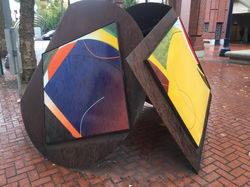Science Communication
In today’s world, it’s not only pursuing science and doing research but communicating about it effectively that’s important. I completed my MA at Duke University in Bioethics and Science Policy program, and in this program, I've learned a lot about science communication. In fact, I cannot emphasize enough how important it has proven to be in my Ph.D. career in Environmental Science under the free-choice learning track at Oregon State University.
Communicating about science, online and ‘out there’ in the world, can trigger life-long science learning. The hard thing is that most of the time we tend to limit our conversations to other scientists. Yet we forget that science communication is a way to bridge the gap between the ‘science world’ and the general, non-scientist public.
In my opinion, science communication has the potential to kick-start a stronger link between the public and scientific values, locking science into the public consciousness. I believe this will lead to better scientists, research, funding, and hopefully better science articles in the newspapers. However, a big change like this cannot happen overnight. It would require a radical shift in everyone’s attitudes towards science communication. Scientists would need the capability and the willingness to explain their work to others and there must be a change in education to make science accessible to the public. I believe by doing so, science and society could regain the respect they’re currently lacking for each other and notice that science is everywhere and can be fun.
If you’re interested in learning more about building your science communication skills in different fields of science, visit Chinmaya’s website and online community The Addictive Brain.
Other useful science communication resources:
 |  |  |
|---|---|---|
 |  |  |
 |  |  |
 |  |  |
 |  |  |
 |  |  |
 |  |  |
 |  |  |
 |  |  |
The beauty of Nature
Janet's world with wild life and nature

Durham–Orange Light Rail Transit (DOLRT) was a planned 17.7-mile (28.5 km) light rail line in central North Carolina. It was intended to start operating in 2028 between North Carolina Central University (NCCU) in eastern Durham and the UNC Medical Center in Orange County. This line was being developed by regional transit agency GoTriangle, and whether Duke would like to participate in this project will make a great difference.
What are Duke interests and concerns on the light rail project? What decision will Duke make in the final?
Janet Yang
Policy Brief

Draft Guidance on whether Groups of Facilities are subject to New Source Review (NSR) under Clean Air Act (CAA)
Interpreting “Adjacent” for New Source Review and Title V Source Determinations in All Industries Other Than Oil and Gas (Draft Guidance, 2018)
Narrows the circumstances under which EPA will consider a group of stationary sources to be “adjacent” for the purposes of the Clean Air Act’s New Source Review (NSR) and Title V programs, limiting the number of sources subject to regulation.
POLICY PROGRESS
FLAIR
International Energy Agency Report on Energy Efficiency
From IEA
Energy efficiency can bring significant economic, social and environmental benefits. But while energy efficiency is improving around the world, its positive impact on global energy use is overwhelmed by rising economic activity across all sectors.
Energy Efficiency 2018 looks at why efficiency’s massive potential remains untapped, and through the new Efficient World Scenario explores what would happen if countries maximized all available cost-effective efficiency potential between now and 2040, highlighting what policy makers can do to realise this opportunity.
Project
Environment, Ecology, Economic & Health
Ethics, Law & Science

H O R S E S H O E C R A B M A N A G E M E N T
SITUATIONAL ASSESSMENT OF CONFLICT SURROUNDING U.S. HORSESHOE CRAB POPULATIONS
By Sophia M. and Janet Y.
Horseshoe crab blood is used broadly in biomedical testing in order to test for the presence of harmful bacteria such as E. coli and Salmonella (Juan Sanz 2016). These bacteria are responsible for hundreds of thousands of bacterial infections every year, leading them to be huge concerns for the biomedical industry (CDC 2019). In order to combat this problem, researchers have harnessed the ability to utilize a compound found in horseshoe crab blood known as Limulus amebocyte lysate (LAL). In order to meet with the needs of the biomedical industry, hundreds of thousands of horseshoe crabs are bled every year (ASFMC 2018). Conservationists have concerns that the overuse of horseshoe crabs is leading to a negative effect on the ecosystem as a whole since human-beings are not the only species that need these spider-like arthropods. How to solve the conflict among stakeholders and lead to the win-win result will be the main issue in this conflict resolution report.
TED
How I fell in love with bugs, nature, and science
My first love is for bugs. Their amazing color, their specific behavior, and their surprising life cycle. Love is complicated. I have fallen in love with nature since I was seven. Strolling in the mountains, catching fish, raising insects…and curious about the mechanism behind them. This is a concept called place-based learning.
Place-based learning can lead to life-long science learning and help us develop an appreciation for science and an understanding of what science entails, and quite frankly, they show us that science can be fun! This all started as a love story. And it still is. This love transformed me from a curious, stargazing young girl to an ecologist and leading me to be trained as a science educator.
Enjoy the Talk

Scientific Illustration
Click to Download
Gallery






